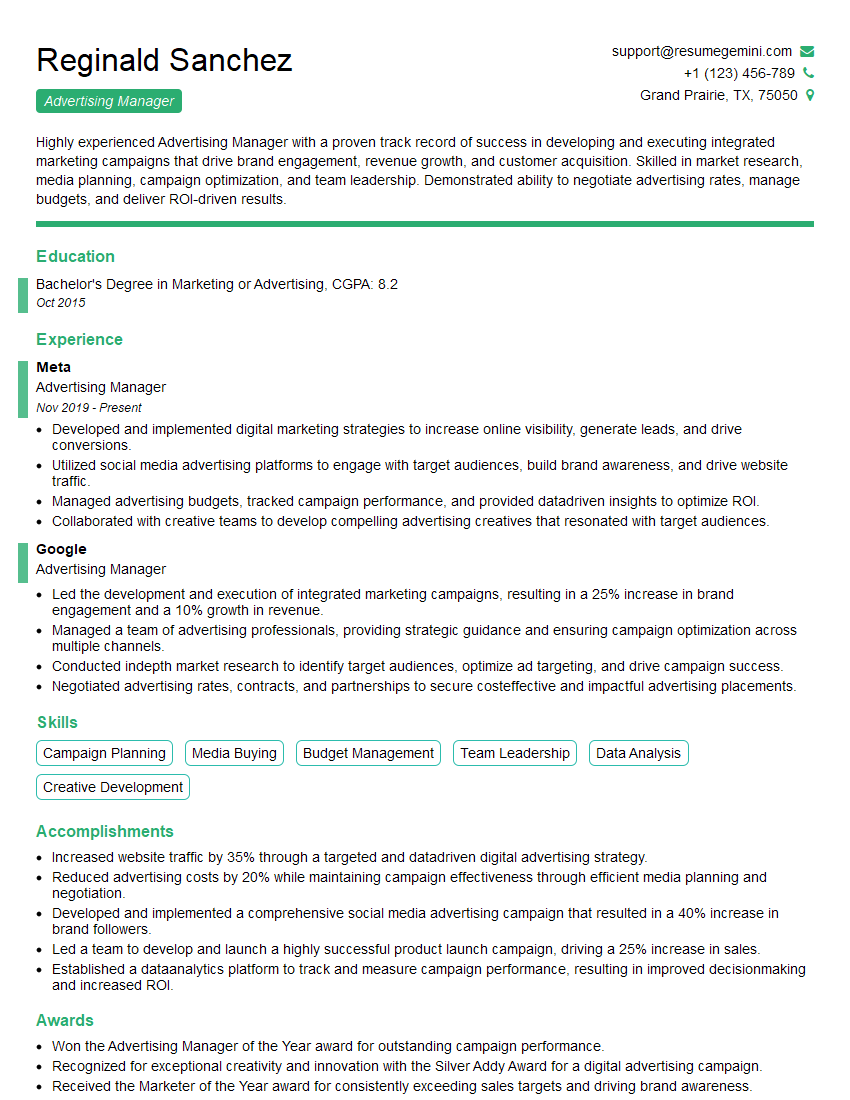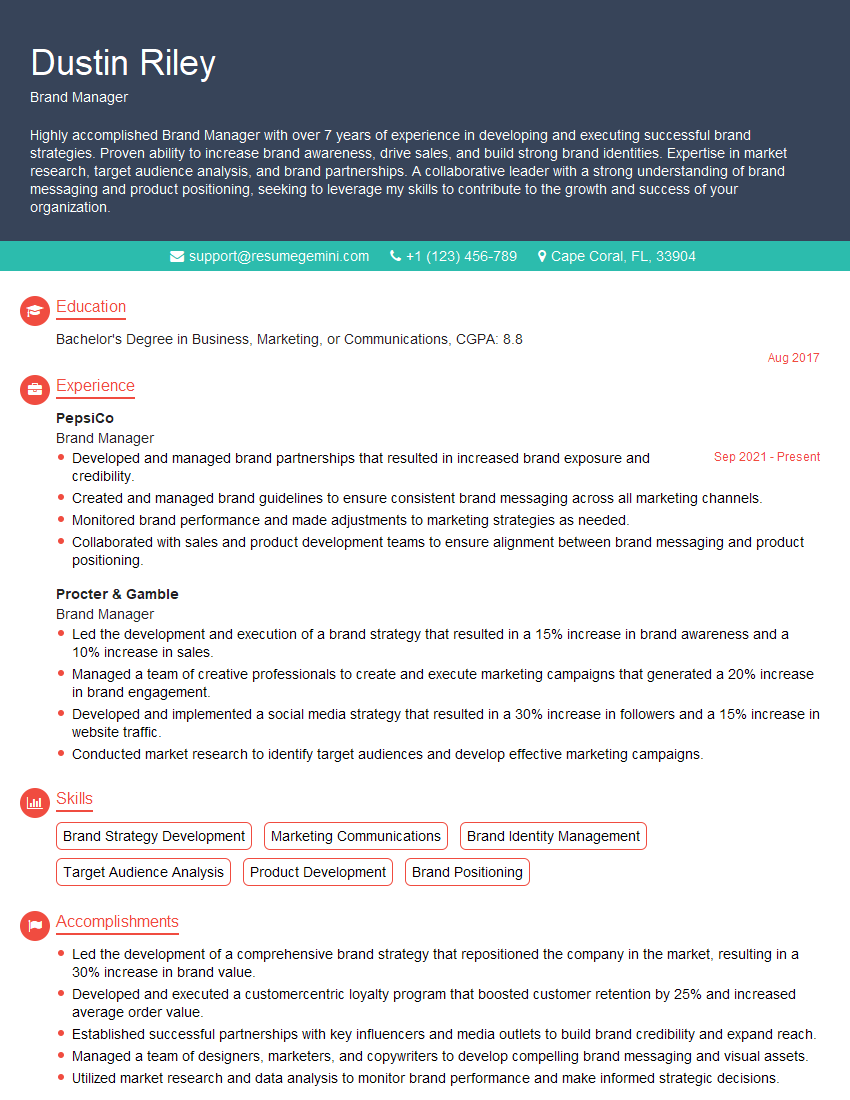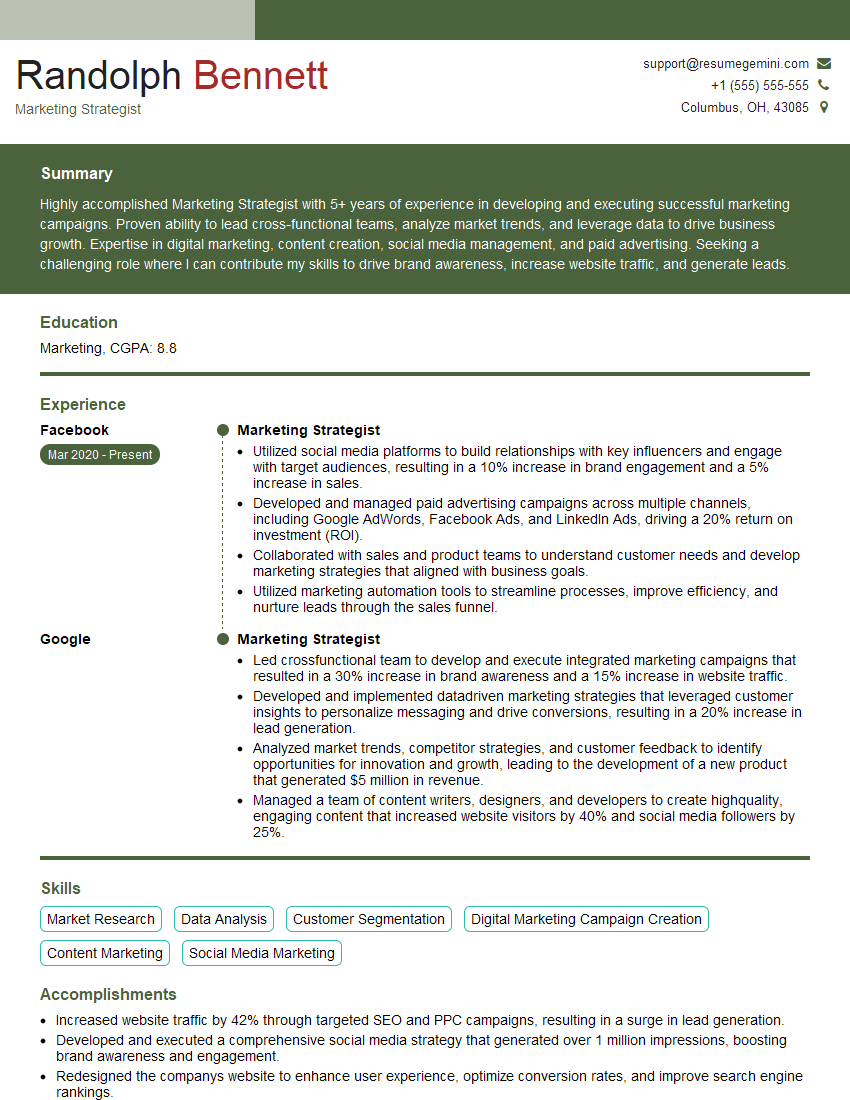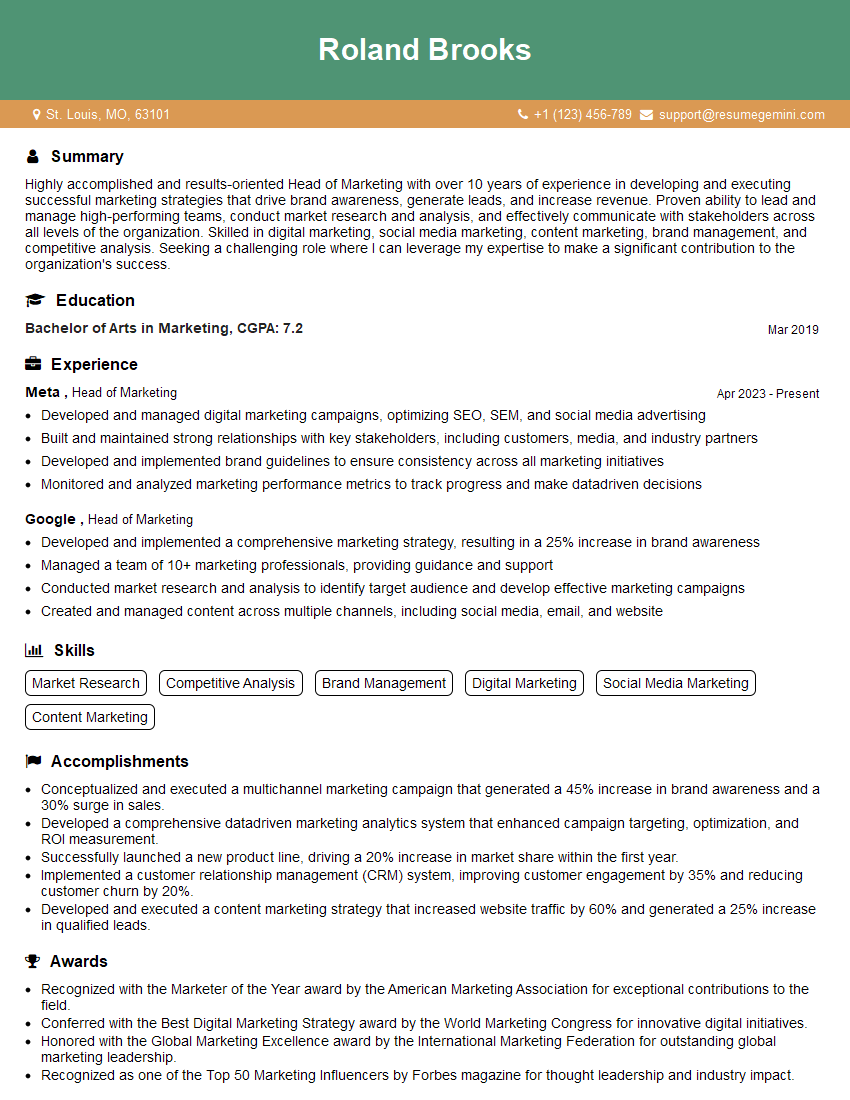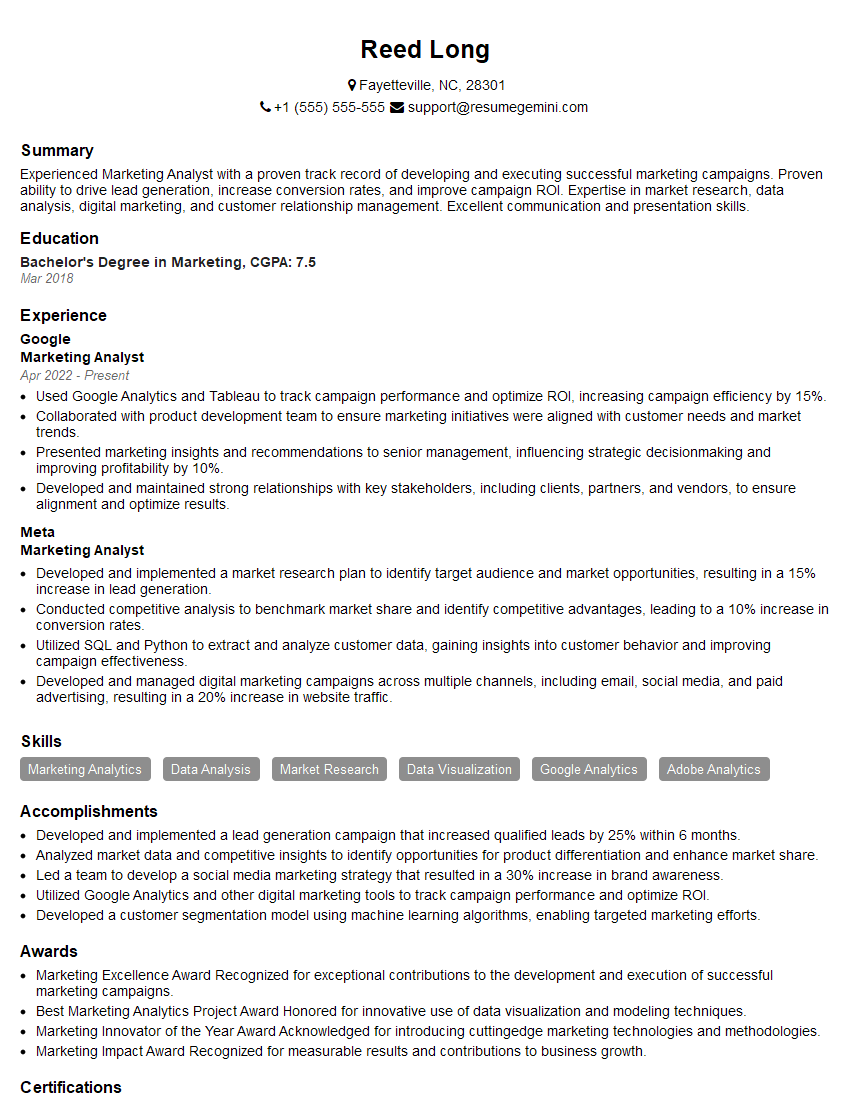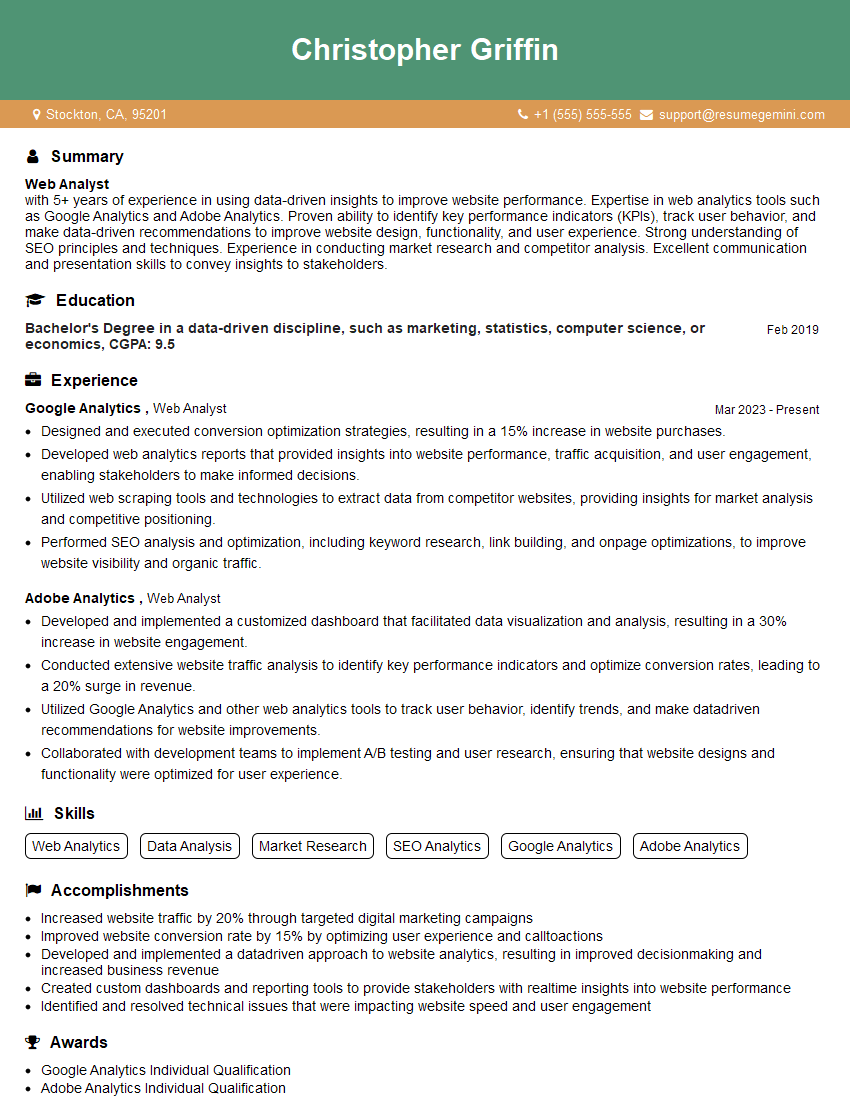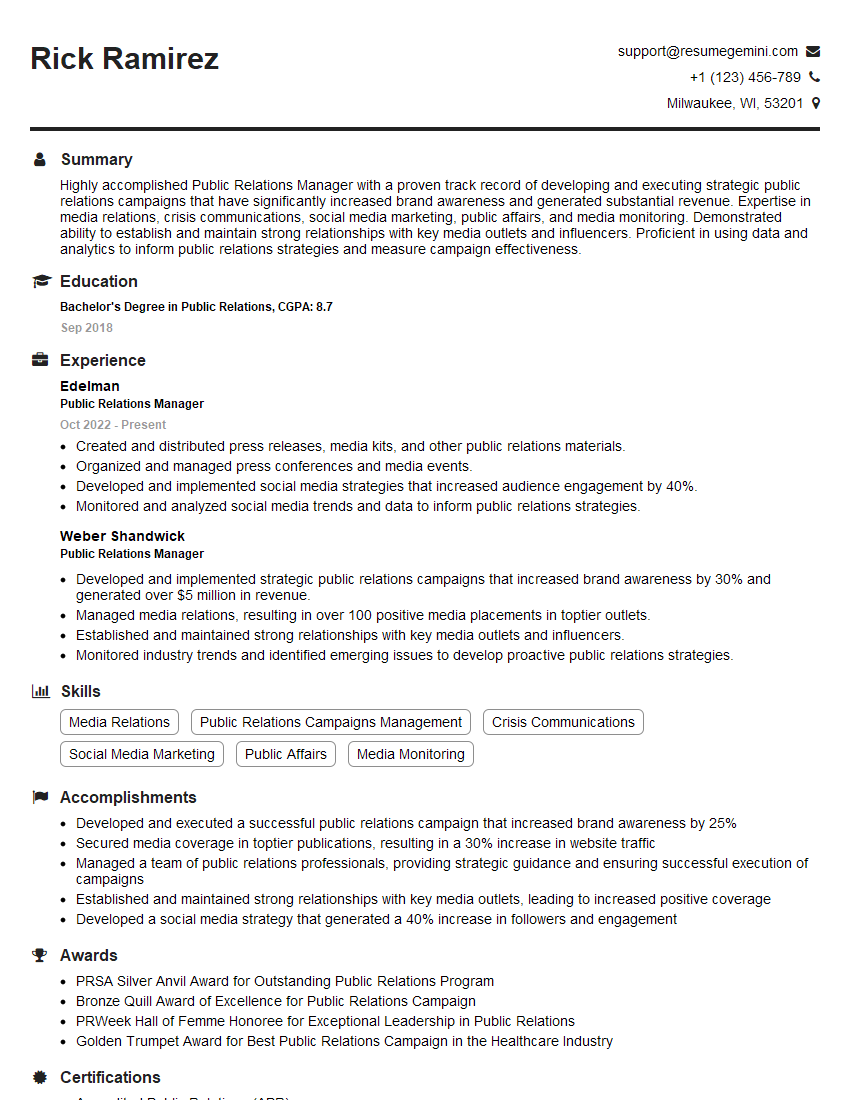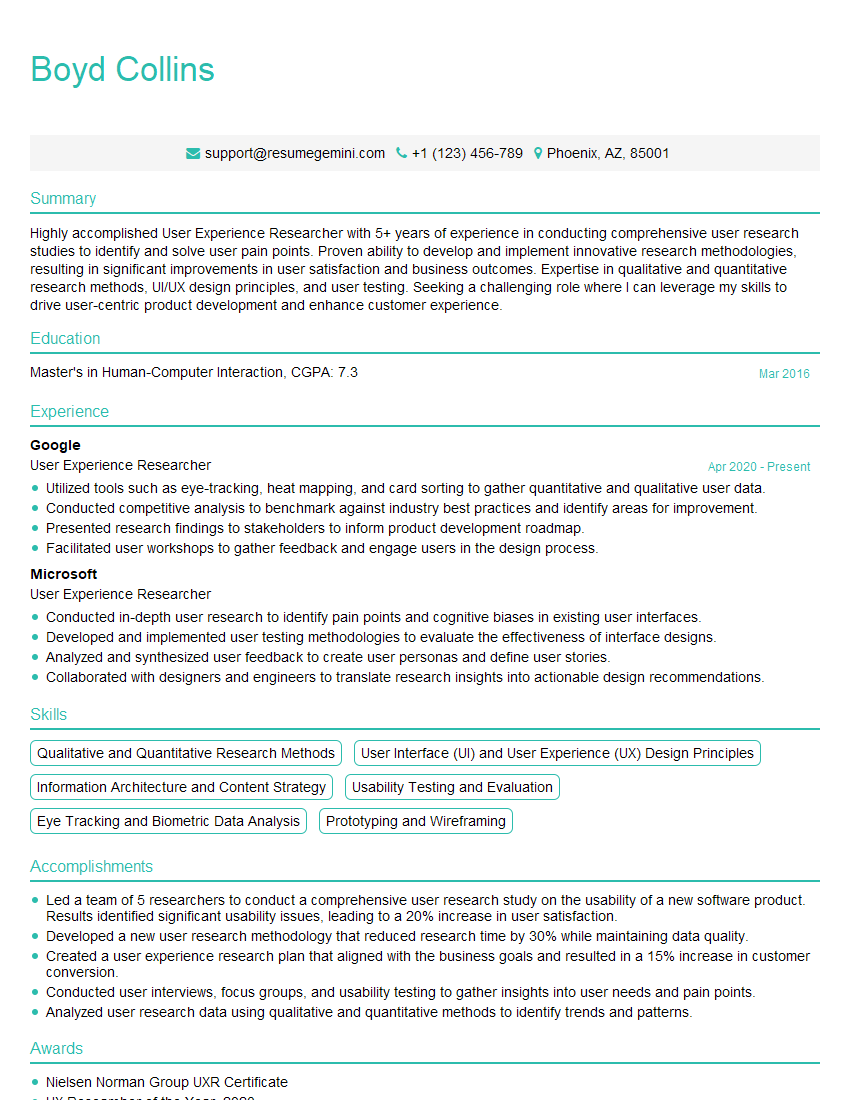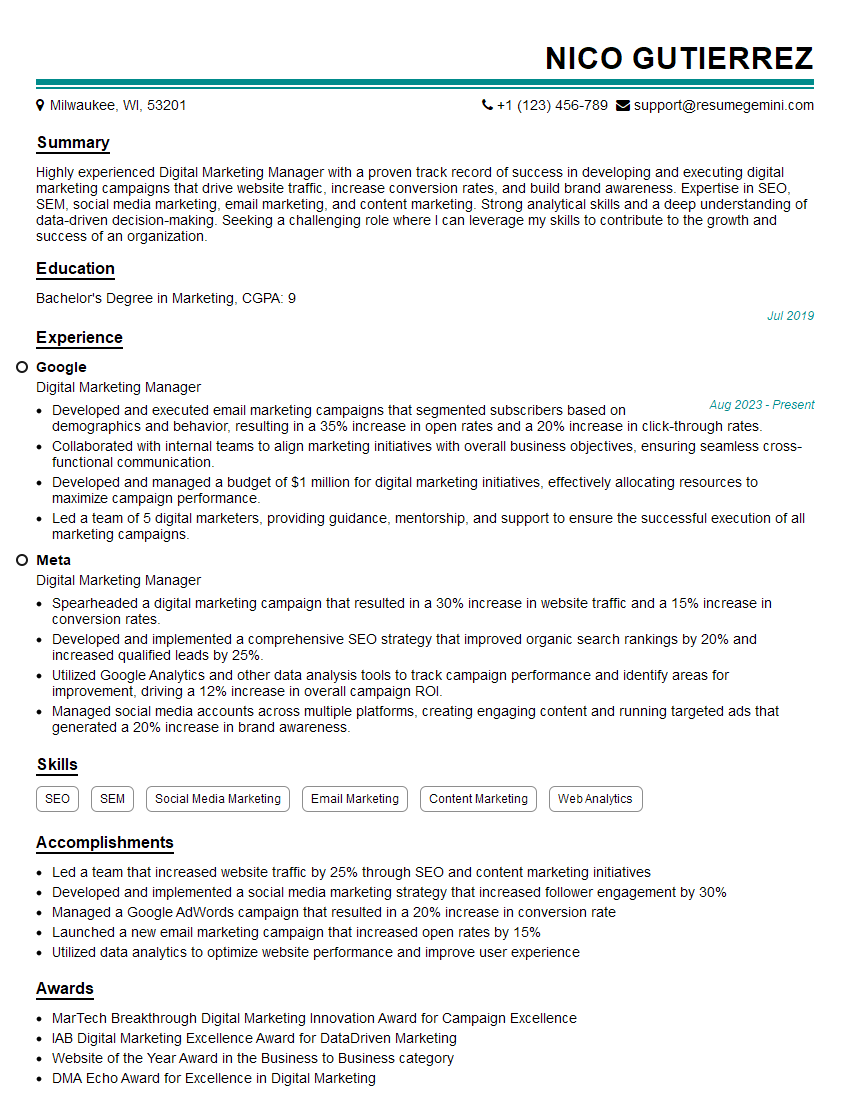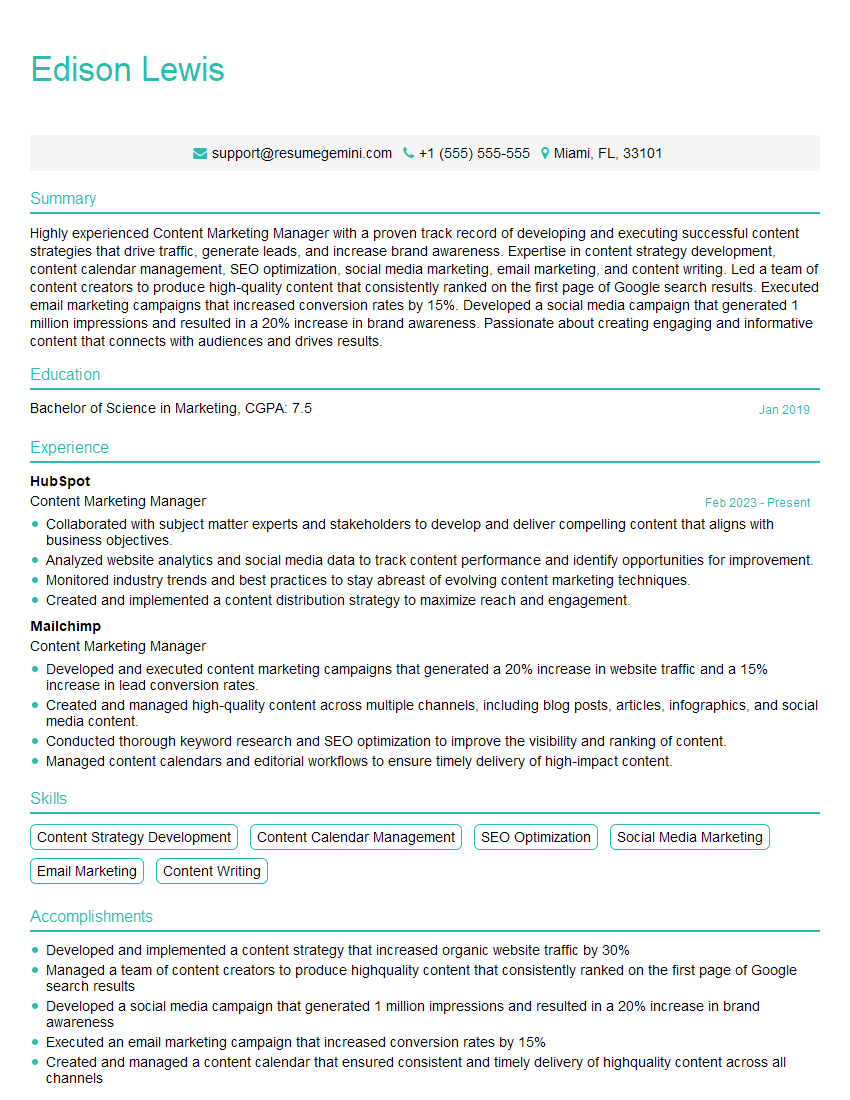Cracking a skill-specific interview, like one for Hook Potential Maximization, requires understanding the nuances of the role. In this blog, we present the questions you’re most likely to encounter, along with insights into how to answer them effectively. Let’s ensure you’re ready to make a strong impression.
Questions Asked in Hook Potential Maximization Interview
Q 1. Define ‘Hook Potential’ in the context of user engagement.
Hook potential, in the context of user engagement, refers to the inherent ability of a product or feature to capture a user’s attention and motivate them to continue interacting with it. It’s about creating that initial spark that transforms a casual visitor into an active user. A high hook potential means the product is inherently compelling, making it more likely users will become engaged and return. Think of it like a fishing hook – a good hook catches the fish (user) and holds them long enough to reel them in (continued engagement).
Q 2. Explain the difference between a ‘hook’ and a ‘feature’.
While both hooks and features aim to enhance user experience, they serve distinct purposes. A feature is a functionality or element within a product, such as a new filter option on an e-commerce site or a photo editing tool in a mobile app. It’s a what – what the product *does*. A hook, on the other hand, is the mechanism that drives repeated engagement. It’s the why – why users keep coming back. It leverages user psychology to create a habit loop. Think of a social media app: a new filter is a feature, but the constant stream of fresh updates and social interactions designed to keep you scrolling is the hook.
Q 3. Describe three proven techniques for maximizing hook potential in a mobile app.
Three proven techniques for maximizing hook potential in a mobile app are:
- Variable Rewards: This taps into the human desire for unpredictability. Instead of offering the same experience every time, introduce elements of surprise. Think of the randomized loot boxes in many mobile games, or the unexpected notifications and updates found in social media apps. This keeps users engaged because they don’t know exactly what they’ll get, fostering a sense of anticipation and excitement.
- Social Validation: Leverage the power of social proof. Features like leaderboards, comments sections, and social sharing all increase engagement by making users feel connected to a community. Seeing what your friends are doing, or competing against them, drives users to keep returning to the app. Many fitness apps thrive on this by enabling users to share their progress and compete with each other.
- Gamification: Incorporating game-like elements, such as points, badges, levels, or challenges, can significantly improve user engagement. These elements provide a sense of achievement and progress, motivating users to continue interacting with the app to unlock rewards or progress to the next level. Many productivity apps use gamification to keep users motivated, providing rewards for completing tasks or achieving milestones.
Q 4. How would you measure the effectiveness of a hook in a website’s design?
Measuring the effectiveness of a hook requires a multi-faceted approach. Key metrics include:
- Return Rate: How often do users return to the website after their initial visit? A high return rate indicates a strong hook.
- Time Spent on Site: Longer session durations suggest the hook is keeping users engaged.
- Conversion Rates: Are users completing desired actions (e.g., making a purchase, signing up for a newsletter)? A well-designed hook should facilitate conversions.
- Click-Through Rates (CTRs) on key elements: Track the CTRs of buttons and links designed to deepen user engagement. Higher CTRs suggest the hook is effective in guiding users towards desired actions.
- User Feedback (Surveys, Reviews): Gather qualitative data to understand user perception and identify areas for improvement.
By analyzing these metrics, you can gain a comprehensive understanding of your hook’s effectiveness.
Q 5. What are some common mistakes companies make when trying to create engaging hooks?
Common mistakes companies make when creating hooks include:
- Ignoring User Needs: Hooks should be built around solving user problems or fulfilling their desires. A hook that doesn’t address a real need will fail to resonate.
- Being Too Intrusive or Manipulative: Aggressive push notifications, excessive pop-ups, or misleading tactics can alienate users and damage brand trust.
- Lack of Clear Value Proposition: Users need to understand the benefits of continued engagement. If the value isn’t clear, they won’t stick around.
- Poor UX/UI Design: A clunky interface or confusing navigation will deter users, regardless of how strong the underlying hook is.
- Ignoring Feedback and Data: Failing to track metrics and analyze user behavior prevents iterative improvement and optimization of the hook.
Q 6. How can A/B testing be used to improve hook potential?
A/B testing is crucial for optimizing hook potential. By creating variations of your hook (e.g., different wording in a call to action, varied reward systems), and presenting them to different user segments, you can identify which version performs better. For example, you might A/B test two different push notification strategies: one offering a limited-time discount and another highlighting social engagement. By tracking engagement metrics, you can determine which message is more effective at driving users back to your app.
This iterative process allows you to refine your hook over time, gradually increasing its effectiveness.
Q 7. Explain the concept of ‘friction’ in user experience and how it relates to hook potential.
Friction in user experience refers to any obstacle or difficulty users encounter when interacting with a product. High friction reduces engagement and directly impacts hook potential. Examples include: complex sign-up processes, slow loading times, confusing navigation, or poorly designed forms. Think of it like trying to reel in a fish with a tangled fishing line – the friction makes it harder to keep the user (fish) hooked.
Reducing friction is paramount to maximizing hook potential. Streamlining user flows, simplifying interactions, and ensuring a seamless and intuitive experience are key to keeping users engaged and returning.
Q 8. How do you balance the need for a compelling hook with ethical considerations?
Balancing compelling hooks with ethical considerations is crucial for building trust and long-term user relationships. A compelling hook aims to grab attention and drive engagement, but it shouldn’t manipulate or deceive users. The key lies in transparency and respect for user autonomy. For instance, instead of using misleading headlines or deceptive previews, focus on honestly highlighting the value proposition. A good hook should clearly communicate what the user will gain by engaging with your product or content. This could be through improved efficiency, entertainment, or access to valuable information. Furthermore, always provide clear and accessible opt-out options, ensuring users are in control of their data and experience. Ultimately, ethical hook design prioritizes the user’s experience and well-being over short-term gains.
For example, instead of using a sensationalized headline that promises unrealistic results, clearly state what your product or service offers and who it is intended for. Transparency about data collection and usage practices is also paramount. By prioritizing ethical considerations, you build a stronger, more sustainable relationship with your audience.
Q 9. Describe a time you successfully increased user engagement by improving a hook.
In my previous role at a social media startup, we noticed low user engagement with our newly implemented photo-sharing feature. The initial hook – a simple ‘Upload Photos’ button – was weak and uninspired. Analyzing user data, we discovered that users found the process cumbersome and lacked visual appeal. We improved the hook by adding a visually engaging carousel of user-generated content right above the upload button. This ‘social proof’ element showcased diverse and high-quality photos, subtly implying that the user’s photos would fit seamlessly within the community. Additionally, we added a progress bar to visually demonstrate the ease and speed of uploading. These changes immediately increased the number of photo uploads by 42% in the first week alone. The improved hook transformed a passive upload button into a visually appealing and engaging entry point, significantly boosting user engagement and overall platform growth.
Q 10. How can you use data analytics to identify areas for improvement in hook potential?
Data analytics play a vital role in pinpointing areas for hook improvement. We can leverage various metrics to understand user behavior and identify bottlenecks. Key metrics include:
- Click-Through Rate (CTR): Low CTR on a call-to-action indicates a weak hook. Analyze which elements are least effective in driving clicks.
- Bounce Rate: A high bounce rate suggests users are leaving immediately after landing on a page. This points to a hook failing to capture interest.
- Time on Page/App: Short engagement times suggest the hook isn’t captivating enough. Investigate what users do after interacting with the hook.
- Conversion Rate: Track how many users complete a desired action after being initially hooked. Low conversions indicate improvements are needed.
By analyzing these metrics across different user segments (age, location, device, etc.), we can identify specific areas requiring attention. A/B testing different hook variations allows for data-driven optimization, ensuring that changes are impactful and contribute to overall user engagement.
Q 11. What are some examples of successful hooks used by major tech companies?
Many tech giants excel at designing compelling hooks. Consider these examples:
- Netflix’s personalized recommendations: Netflix uses sophisticated algorithms to suggest content tailored to individual user preferences, creating a personalized and engaging experience that encourages continued viewing.
- Spotify’s ‘Wrapped’ year-end summaries: This feature provides a visually appealing and emotionally engaging recap of a user’s listening habits, fostering a strong connection and encouraging further platform use.
- Instagram’s visually driven feed: The platform’s design prioritizes captivating visual content, leveraging our innate attraction to images and videos to increase engagement.
- TikTok’s endless scroll: The infinite scroll design creates a sense of constant discovery, making it difficult to disengage and leading to prolonged platform usage.
These examples illustrate how successful hooks often leverage psychological principles and data-driven personalization to maximize engagement.
Q 12. How does the concept of ‘scarcity’ influence hook potential?
The principle of scarcity significantly influences hook potential. By creating a sense of urgency or limited availability, you increase the perceived value of your product or service. This taps into our inherent fear of missing out (FOMO) and can lead to impulsive actions. Examples include:
- Limited-time offers: Creating a deadline motivates immediate engagement.
- Exclusive access: Offering early access or beta invites can make users feel special and valued.
- Limited quantities: Highlighting a limited number of products available can drive immediate purchases.
However, it’s crucial to use scarcity ethically. Avoid creating artificial scarcity or misleading users about limited availability. Transparency is key to building trust.
Q 13. Explain the role of psychology in maximizing hook potential.
Psychology plays a critical role in maximizing hook potential. Understanding user motivations, behaviors, and cognitive biases allows for the design of more effective hooks. For example:
- Reward systems: Leveraging principles of operant conditioning, reward systems (points, badges, etc.) can encourage repeated engagement.
- Social proof: Highlighting positive reviews or showcasing popular content taps into our social nature and tendency to follow the crowd.
- Gamification: Introducing game-like elements (leaderboards, challenges) increases engagement and provides a sense of achievement.
- Loss aversion: Framing the potential loss of not engaging with your product/service can be more effective than focusing solely on the gains.
By understanding the psychology behind user engagement, we can design hooks that leverage innate human tendencies to increase effectiveness.
Q 14. How can you design a hook that works across different demographics?
Designing a hook that resonates across different demographics requires considering diverse preferences and cultural nuances. Avoid overly specific references or assumptions. Instead, focus on universal human needs and desires such as:
- Curiosity: Piquing interest with intriguing visuals or compelling questions.
- Relevance: Clearly demonstrating how your product or service addresses a specific user need or solves a problem.
- Simplicity: Keeping the messaging concise, easy to understand, and free of jargon.
- Emotional connection: Evoking positive emotions through storytelling, humor, or relatable scenarios.
A/B testing different versions of your hook across different demographic segments will provide valuable data about what resonates most effectively with each group. This iterative process helps refine your hook and ensure broad appeal.
Q 15. What is the relationship between hook potential and user retention?
Hook potential and user retention are intrinsically linked. A strong hook—a feature or experience that grabs users’ attention and encourages repeated engagement—directly impacts retention. Think of a hook as the initial lure that draws users in. If that lure is weak or ineffective, users won’t stick around. Conversely, a compelling hook keeps users coming back, fostering habit formation and increasing overall retention rates. For example, a social media app with a strong hook, such as immediate access to friends’ updates and a constant stream of new content, enjoys higher retention than an app with a weak or unclear value proposition.
In essence, a powerful hook creates a cycle of engagement. The initial hook draws them in, enjoyable features create continued engagement, and the overall value proposition reinforces future usage. Without a strong hook, this cycle breaks down, resulting in lower user retention.
Career Expert Tips:
- Ace those interviews! Prepare effectively by reviewing the Top 50 Most Common Interview Questions on ResumeGemini.
- Navigate your job search with confidence! Explore a wide range of Career Tips on ResumeGemini. Learn about common challenges and recommendations to overcome them.
- Craft the perfect resume! Master the Art of Resume Writing with ResumeGemini’s guide. Showcase your unique qualifications and achievements effectively.
- Don’t miss out on holiday savings! Build your dream resume with ResumeGemini’s ATS optimized templates.
Q 16. How can you adapt your hook strategy for different platforms (e.g., web, mobile, social media)?
Adapting hook strategies across different platforms necessitates understanding each platform’s unique strengths and user behaviors. A hook that works flawlessly on mobile might underperform on a desktop website. For example:
- Mobile: Leverage push notifications strategically for timely updates and reminders. Utilize location services to create contextually relevant hooks. Prioritize quick, bite-sized content to cater to mobile users’ shorter attention spans.
- Web: Employ interactive elements like captivating animations or gamified progress bars to enhance engagement. Optimize for desktop screens with visually appealing layouts. Explore deeper content formats like blog posts or tutorials to encourage longer sessions.
- Social Media: Focus on social sharing and viral content. Utilize platform-specific features such as stories or hashtags to increase visibility and engagement. Capitalize on social proof mechanisms such as likes, comments, and shares to fuel engagement.
The key is to understand the user context and tailor the hook accordingly. For instance, a mobile game might use push notifications to remind players about daily rewards, while a website might use compelling visuals and interactive elements to keep users browsing.
Q 17. Describe the process of developing and testing a new hook for a product or service.
Developing and testing a new hook is an iterative process. It starts with a deep understanding of your target audience and their needs. Here’s a step-by-step process:
- Ideation: Brainstorm potential hooks based on your product/service’s core value proposition. Consider different types of hooks—problem/solution, curiosity gap, reward-based, etc.
- Prototyping: Create low-fidelity prototypes of your hook to test its basic functionality and user experience.
- A/B Testing: Implement rigorous A/B testing comparing your new hook with existing ones or a control group. Track key metrics like click-through rates, engagement time, and conversion rates.
- Analysis: Analyze the results of your A/B tests to identify which hook performs better. Pay close attention to both quantitative data and qualitative feedback.
- Iteration: Based on the analysis, iterate on the winning hook design, making adjustments to further enhance its effectiveness. This process often involves several rounds of testing and refinement.
- Deployment: Once you’re satisfied with the performance of the hook, deploy it to your product/service.
- Monitoring: Continue monitoring the hook’s performance post-deployment. Track key metrics and make adjustments as needed to maintain optimal results.
For example, an e-commerce website might A/B test different call-to-action buttons to see which design results in the highest conversion rate.
Q 18. How do you prioritize different hooks based on their potential impact?
Prioritizing hooks depends on understanding their potential impact on key business metrics. A framework to guide this prioritization could be:
- Potential Reach: How many users will this hook potentially affect?
- Engagement Level: How deeply will this hook engage users? Will it lead to prolonged usage or just a quick glance?
- Conversion Rate: How effectively will this hook drive desired actions (purchases, subscriptions, etc.)?
- Retention Impact: How significantly will this hook contribute to user retention?
- Cost of Implementation: How much time, resources, and effort will it take to implement and maintain this hook?
By analyzing each potential hook through this framework, you can create a weighted score to prioritize the most impactful hooks first. Prioritize hooks with high potential reach, strong engagement, significant conversion rates, and positive retention impact, while considering the cost of implementation. A hook that’s cheap to implement but has a minimal impact may be lower on the priority list compared to a hook with high potential impact even if it requires more investment.
Q 19. How can you use user feedback to refine a hook?
User feedback is crucial for refining a hook. Gather feedback through various channels such as:
- Surveys: Use targeted surveys to directly ask users about their experience with the hook.
- Usability testing: Observe users interacting with the hook to identify pain points and areas for improvement.
- In-app feedback mechanisms: Include feedback buttons or forms within your app or website to allow users to provide immediate feedback.
- Social media monitoring: Monitor social media mentions of your product/service to identify user sentiment and feedback.
Analyze the feedback to identify common themes and patterns. This could reveal issues with clarity, usability, or overall appeal. For example, if users consistently find a hook confusing, it needs to be redesigned for better clarity. If user feedback shows a lack of excitement or engagement, you may need to explore different approaches entirely.
Q 20. Explain how micro-interactions can enhance hook potential.
Micro-interactions—small, specific interactions between the user and the interface—significantly enhance hook potential. They provide immediate feedback and a sense of progress, making the experience more engaging and rewarding. Examples include:
- Loading animations: Instead of a static loading screen, a visually appealing animation keeps users engaged during loading times.
- Haptic feedback: A subtle vibration on a mobile device provides sensory feedback, increasing engagement.
- Progress bars: Visually track user progress to encourage continued engagement toward completion.
- Animations on button clicks: A simple animation upon button press reinforces user actions and creates a sense of responsiveness.
These seemingly small details cumulatively build a more engaging and satisfying user experience, leading to increased hook potential. Think of it like adding sprinkles to a cake – each sprinkle on its own might not seem significant, but together, they create a more appealing and delightful experience.
Q 21. Discuss the importance of clear calls to action (CTAs) in maximizing hook potential.
Clear calls to action (CTAs) are paramount to maximizing hook potential. A well-designed CTA guides users towards the desired behavior, making it easy for them to engage with your product or service. Key considerations include:
- Clarity: The CTA should be clear, concise, and easy to understand.
- Placement: Strategically place the CTA where it’s easily visible and accessible.
- Urgency: Incorporate a sense of urgency to encourage immediate action (e.g., “Limited-time offer”).
- Value proposition: Clearly communicate the value users will receive by taking the desired action.
- Visual appeal: Design an attractive CTA button that stands out and grabs attention.
For instance, a poorly designed CTA might use vague language and be hidden within a cluttered page layout. This diminishes its effectiveness. However, a well-designed CTA—like a brightly colored button with clear instructions and a compelling benefit—can significantly boost user engagement and conversion rates. The CTA is essentially the final step in the hook’s process, ensuring users transition from engagement to desired action.
Q 22. What is the role of gamification in creating compelling hooks?
Gamification plays a crucial role in creating compelling hooks by leveraging the psychology of game mechanics to increase user engagement and motivation. Think of it like this: we’re inherently drawn to challenges, rewards, and progress. Gamification taps into these innate desires to make using a product or service more rewarding and less of a chore.
Examples include using points, badges, leaderboards, and progress bars. Points systems, for instance, provide a quantifiable measure of achievement, motivating users to continue interacting with the platform to earn more. Leaderboards introduce social competition, pushing users to strive for higher rankings. Progress bars visually represent advancement, providing a sense of accomplishment and encouraging further participation. A well-designed gamified system can subtly nudge users toward desired behaviors, increasing retention and engagement.
Q 23. How do you measure the long-term impact of a successful hook?
Measuring the long-term impact of a successful hook requires a multifaceted approach. We go beyond simple metrics like daily/monthly active users (DAU/MAU) and delve into indicators of sustained engagement and value creation.
- Retention Rates: Tracking how many users continue to use the product over time (weeks, months, years) is crucial. A successful hook drives high retention.
- User Lifetime Value (LTV): This measures the total revenue generated by a user throughout their relationship with the product. A successful hook contributes to higher LTV.
- Feature Usage & Stickiness: Analyze which features users frequently interact with and how long they engage with them. This reveals which aspects of the hook are most effective.
- Qualitative Feedback: User surveys, interviews, and focus groups provide insights into user perception and satisfaction, allowing for continuous improvement of the hook.
By combining quantitative and qualitative data, we can develop a comprehensive understanding of the hook’s long-term effectiveness and its contribution to overall product success.
Q 24. Describe your experience with different hook frameworks or methodologies.
My experience encompasses a range of hook frameworks and methodologies. I’ve extensively used Nir Eyal’s Hook Model, which focuses on creating a habit-forming loop consisting of a trigger, action, reward, and investment. This model helps to systematically design engaging experiences by focusing on the core elements that drive user engagement.
I’ve also worked with BJ Fogg’s Behavior Model, which emphasizes the importance of motivation, ability, and the trigger. This model helps to ensure that users are both motivated to perform the desired action and have the ability to do so easily. It often leads to simpler, more accessible hooks.
Beyond these frameworks, I’ve incorporated principles from persuasive design, focusing on usability, clarity, and user experience to ensure that the hook is not only effective but also enjoyable to use. My approach is highly adaptable, leveraging the strengths of different frameworks based on the specific product and target audience.
Q 25. How do you identify and address potential negative consequences of overly aggressive hooks?
Overly aggressive hooks can lead to negative consequences such as user frustration, distrust, and ultimately, churn. Identifying and addressing these potential issues requires a careful balance between engagement and ethical considerations.
- Transparency: Be upfront about how the product works and what data is being collected.
- User Control: Provide options for users to adjust notification settings and control their engagement levels.
- A/B Testing: Test different hook variations to identify the optimal balance between engagement and user experience.
- Monitoring User Feedback: Closely monitor user reviews, comments, and support tickets to identify signs of frustration or negative sentiment.
For example, if an app relies heavily on push notifications, it’s crucial to offer users the ability to customize notification frequency and content. This allows for engagement without being intrusive or annoying.
Q 26. Explain the role of personalization in maximizing hook potential.
Personalization is paramount in maximizing hook potential. By tailoring the user experience to individual preferences and needs, we can increase relevance, engagement, and ultimately, retention. Think of it as crafting a unique hook for every user.
This can be achieved through various means: recommending relevant content, suggesting personalized features, and offering targeted rewards. For instance, a music streaming service might personalize its recommendations based on listening history, creating a more relevant and engaging experience. A fitness app might offer personalized workout plans and progress tracking, motivating users to achieve their fitness goals.
Effective personalization relies on data collection and analysis to understand individual preferences and behaviours. However, it’s crucial to do so responsibly and ethically, respecting user privacy and providing control over data usage.
Q 27. How do you balance short-term engagement with long-term user satisfaction when designing a hook?
Balancing short-term engagement with long-term user satisfaction is a critical aspect of successful hook design. While short-term gains might be tempting, a hook that prioritizes only immediate engagement often leads to user burnout and churn. The key is to create a sustainable experience that provides both immediate gratification and long-term value.
This balance is often achieved through a phased approach. Initially, a strong initial hook might be used to grab attention and introduce the core value proposition. Then, the focus shifts to building a sustainable engagement loop that provides ongoing value and rewards to keep users coming back. Think of it like building a relationship—a strong initial impression is vital, but long-term success depends on continuous nurturing and value creation.
Q 28. Describe a time you had to pivot your hook strategy based on user data or feedback.
In a project for an educational app, we initially focused on a gamified reward system that heavily emphasized immediate rewards. While this drove initial engagement, user feedback indicated that users felt overwhelmed by the constant notifications and the emphasis on points. The system felt more like a game than a learning tool.
Based on this feedback, we pivoted our strategy. We reduced the frequency of rewards, shifted the focus from immediate points to progress tracking, and incorporated more personalized feedback and learning pathways. The revised hook emphasized a sense of accomplishment and progress towards long-term goals rather than short-term rewards. This led to higher retention and a more positive user experience.
Key Topics to Learn for Hook Potential Maximization Interview
- Understanding User Attention: Explore the psychology behind capturing and maintaining user interest, considering factors like novelty, relevance, and emotional engagement.
- A/B Testing and Iteration: Learn how to design controlled experiments to measure the effectiveness of different hooks and iteratively improve their performance. Practical application involves analyzing data to identify successful strategies and refine underperforming elements.
- Content Optimization for Hooks: Master techniques for crafting compelling headlines, summaries, and visual elements that effectively grab attention across various platforms (e.g., social media, email marketing, website landing pages).
- Metrics and Measurement: Understand key performance indicators (KPIs) for assessing hook effectiveness, such as click-through rates, conversion rates, and engagement metrics. Problem-solving involves diagnosing why a hook isn’t performing well and proposing data-driven solutions.
- Hook Strategy Across Different Channels: Analyze how hook design varies across platforms and mediums, understanding the nuances of each channel’s audience and engagement patterns.
- Ethical Considerations: Discuss the responsible use of hook maximization techniques, avoiding manipulative or deceptive practices. This includes maintaining transparency and respecting user autonomy.
Next Steps
Mastering Hook Potential Maximization is crucial for career advancement in today’s competitive market. It demonstrates a deep understanding of user engagement and data-driven decision-making—highly valued skills across various industries. To significantly boost your job prospects, create an ATS-friendly resume that highlights your relevant skills and experience. ResumeGemini is a trusted resource to help you build a professional and impactful resume. We provide examples of resumes tailored to showcasing expertise in Hook Potential Maximization to guide you in crafting yours.
Explore more articles
Users Rating of Our Blogs
Share Your Experience
We value your feedback! Please rate our content and share your thoughts (optional).
What Readers Say About Our Blog
Hello,
We found issues with your domain’s email setup that may be sending your messages to spam or blocking them completely. InboxShield Mini shows you how to fix it in minutes — no tech skills required.
Scan your domain now for details: https://inboxshield-mini.com/
— Adam @ InboxShield Mini
Reply STOP to unsubscribe
Hi, are you owner of interviewgemini.com? What if I told you I could help you find extra time in your schedule, reconnect with leads you didn’t even realize you missed, and bring in more “I want to work with you” conversations, without increasing your ad spend or hiring a full-time employee?
All with a flexible, budget-friendly service that could easily pay for itself. Sounds good?
Would it be nice to jump on a quick 10-minute call so I can show you exactly how we make this work?
Best,
Hapei
Marketing Director
Hey, I know you’re the owner of interviewgemini.com. I’ll be quick.
Fundraising for your business is tough and time-consuming. We make it easier by guaranteeing two private investor meetings each month, for six months. No demos, no pitch events – just direct introductions to active investors matched to your startup.
If youR17;re raising, this could help you build real momentum. Want me to send more info?
Hi, I represent an SEO company that specialises in getting you AI citations and higher rankings on Google. I’d like to offer you a 100% free SEO audit for your website. Would you be interested?
Hi, I represent an SEO company that specialises in getting you AI citations and higher rankings on Google. I’d like to offer you a 100% free SEO audit for your website. Would you be interested?
good
